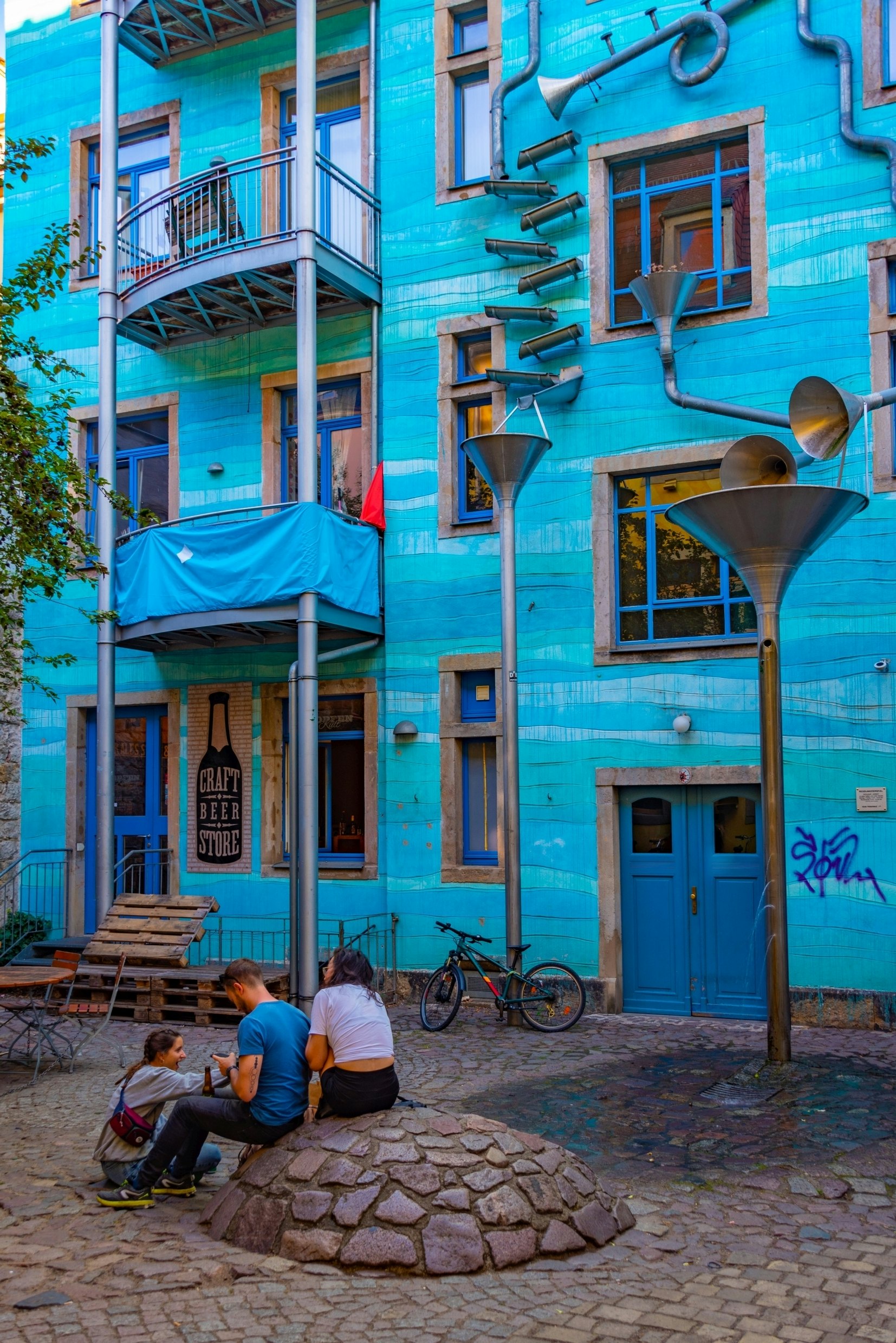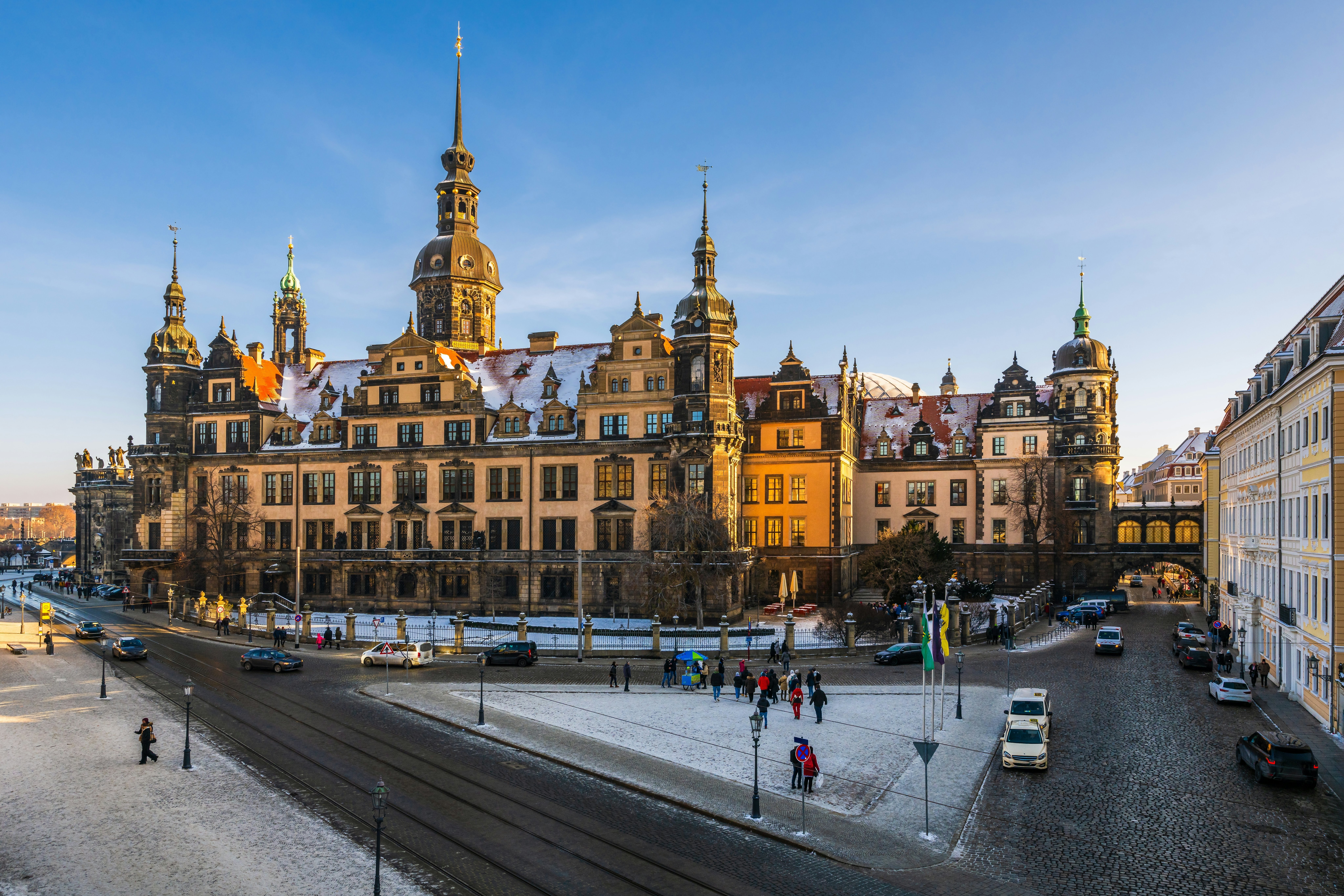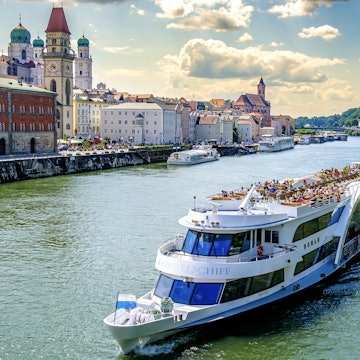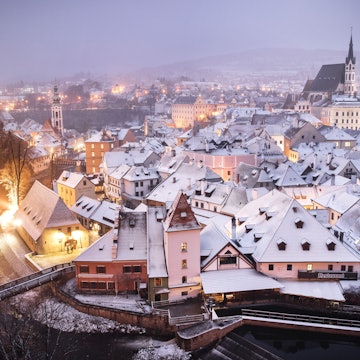

Dresden’s Striezelmarkt, Christmas market. querbeet/Getty Images.
Dresden is a city for time travelers. You can spend a day hopping between beautiful baroque buildings while walking in the footsteps of more recent ghosts that continue to weigh heavy on the city’s soul.
There’s the resplendent Altstadt (Old Town) meticulously reconstructed to its former glory and Christmas Markets that bring light to an otherwise dark time of year. Across the Elbe River, you can find modern Germany with its craft beer, international cuisine and immersive street art. Then, just a short train ride away, sip award-winning wines or head out to the country for some of the most impressive natural views.
Here are the top things to do in Dresden.

1. Grab a cup of Glühwein and get into the Christmas spirit at Striezelmarkt
Germany is known for its Christmas markets, or Weihnachtsmärkte, beginning in late November and stretching through the holiday season in December. You’d be hard-pressed to find a city or village without some kind of Christmas market, complete with food, gifts and of course, Glühwein, the German spin on mulled wine.
If you were to visit just one Christmas market, Dresden’s Striezelmarkt makes a strong case. It's considered by many to be the oldest Christmas market in the country, stretching back nearly 600 years. Visiting Striezelmarkt on the edge of the city's Old Town is like stepping into a winter wonderland, complete with all the sugary sweets and pageantry you can imagine.
2. Climb to the top of Frauenkirche for a panoramic view of the Old Town
Churches in European Old Towns are usually a dime a dozen. But Dresden’s Frauenkirche (Church of Our Lady) stands out for its history and symbolism.
The 18th-century Lutheran Church – along with almost all of Dresden – was destroyed in the fire bombing of WWII in 1945. Post-war leaders initially left the church in ruins as a kind of war memorial until the late 1980s when plans for reconstruction began. Using 8000 salvaged stones, the baroque masterpiece was officially brought back to life in 2005. The golden cross placed atop the dome was constructed by the son of a British pilot who took part in the bombing of Dresden, as an act of reconciliation.
Planning tip: Enjoy spectacular views of the surrounding Neumark from the viewing platform. Find the latest information on opening hours and price of admission online.

3. Take a stroll around the Zwinger
Dresden, in its reconstructed splendor, is a city to simply immerse yourself, and the Zwinger – a prestigious piece of baroque architecture right in the center of the city – is arguably the icing on the cake.
Meant to stand as a testimony to the glory of Augustus the Strong’s reign, the Zwinger quickly developed into a cultural hub until it was destroyed in WWII. The Soviets began reconstruction immediately after the war, largely restoring the building to its pre-war state by 1963. Today it’s popular with photo-hungry tourists, collecting different snaps of the exquisite architecture and art within the complex.
For many, standing in the heart of the Zwinger and taking it all in is enough, but if you do enjoy a good museum, the Porzellansammlung (Porcelain Museum) has an invaluable collection of 17th- and 18th-century Chinese porcelain produced in Meissen. The Gemäldegalerie Alte Meister (Old Masters Gallery) is another great museum here, housing an astounding collection of European art from the 16th to 18th centuries, including an incredible number of masterpieces, like Raphael’s famous Sistine Madonna (1513), which dominates the enormous main hall on the ground floor.
Local tip: Listen for the chimes playing at the Glockenspiel Pavilion every 15 minutes. The melodies are a mix of original compositions by Günter Schwarze and other well-known tunes.
4. See the inspiration for Kurt Vonnegut's book Slaughterhouse-Five
Kurt Vonnegut is known as one of the most profound and prolific writers in American history. But before he made a name for himself as a writer, he dropped out of Cornell University and enlisted in the US Army to fight in WWII. Captured at the Battle of the Bulge, he was interned in Dresden during the devastating and controversial Allied firebombing of the city that left it in ruins. Vonnegut survived the attack by hiding in a meat locker of the slaughterhouse, hence the name of his breakthrough novel, Slaughterhouse-Five.
Tour guide Danilo Hommel quickly saw the potential to turn Vonnegut’s story into an experiential morning for guests interested in learning more about the author and how themes he touched on in his novel resonate today in Dresden. As part of the tour, you'll also learn more about the destruction of Dresden in February 1945 and how the city was rebuilt over the following half century.
Planning tip: Walking into the actual slaughterhouse is not always possible – check with the tour guide in advance for the latest information.

5. Immerse yourself in the art of Kunsthofpassage in Neustadt
Most cities have their street-art neighborhoods and for Dresden it’s Neustadt (New Town) just across the Elbe from the Old Town. But this isn't just captivating imagery, Kunsthofpassage is an immersive experience.
There are a number of courtyards accessible through narrow alleyways where you can quite literally walk into the art. In Hof der Elemente (Courtyard of the Elements) there are a series of twisting silver pipes that look like they belong in a Mario video game before they morph into a trumpet. The Hof des Lichts (Courtyard of Light) contains projection screens to allow for multimedia performances alongside metallic mirrors with colorful reflections that change with the sun’s position. Last but not least, there’s the Hof der Fabelwesen (Courtyard of Mythical Creatures), home to artist Viola Schöpe’s paintings and ceramic mosaics of peculiar beings that resemble a blend of Picasso and Ancient Greek art alongside a two-floor tall giraffe and some monkeys.
Planning tip: When in Neustadt, head to the intersection of Alaunstrasse and Louisenstrasse, where you’ll find Katy’s Garage, featuring an old car on the kitchen roof, the eponymous Katy. Live music is played here regularly. All around, the streets are filled with pop-up cafes and restaurants serving all kinds of international food, from Indian to Georgian. Around the corner, Louisengarten is a slightly more traditional beer-drinking venue.
6. Snap a sunset panoramic photo at Brühl’s Terrace
Dresden and its photogenic Old Town can be overwhelming for anyone with a camera. The exquisite nature of the city demands to be captured by the lens again and again. For the perfect photography spot, head for Brühl’s Terrace – nicknamed “the balcony of Europe.”
This impressive panoramic terrace stretches approximately 500m with a view over the Elbe River. The name stems from Henrich von Brühl, an 18th-century statesman who led the construction of various ornate buildings in Dresden. Stop by a bit before sunset so you have time to wander around the eastern garden before admiring the Renaissance-style terrace itself.
Planning tip: Get your bearings: on your left, the Augustusbrücke meets the dark silhouette of the Holy Trinity Cathedral, a masterpiece by Gaetano Chiaveri and the resting place of Saxon royals from the House of Wettin. Stairs on the opposite side will bring you to the Frauenkirche, the cathedral resurrected to its former magnificence from a pile of post-WWII rubble during the post-Wende decades.

7. Get lost in Residenzschloss Dresden Castle (or Royal Palace)
This Old Town castle is considered to be one of the most important of the Renaissance period, serving as a cultural and political hub since the 15th century. Today the Residenzschloss houses a variety of museums. There’s the Dresden Armory (Rüstkammer) with its collection of armor and weapons, the Grünes Gewölbe, or Green Vault, home to royal treasures, and the Turkish Chamber with its collection of Ottoman art – one of the largest of its kind outside of Türkiye.
At Kupferstich-Kabinett you can find an astounding collection of roughly 500,000 drawings, prints and sketches by the likes of Rembrandt, Michelangelo, and Germany’s own Albrecht Dürer. If somehow that’s not enough, cap it off with the Münzkabinett – literally the coin cabinet – with 300,000 objects from across the globe dating from antiquity to the modern era.
Detour: Explore the Residenzschloss’ royal roots by checking out the east side of the building's exterior where you can find the Fürstenzug mural. This 102m-long (335ft) piece of art displays the 35 rulers of the House of Wetting, stretching from the 12th century up to the final kings of the 19th century.
8. Sip on a glass of wine at Schloss Wackerbarth
When exploring Germany’s celebrated wine regions, Saxony isn’t usually in the conversation. That is, unless you’re talking about Schloss Wackerbarth.
Just outside of Dresden in the town of Radebeul, you can get to the winery and its romantic rolling hills in a little over 30 minutes from the main train station. The award-winning Wackerbarth is one of Europe’s oldest producers of sparkling wine, with a deserved renowned reputation.
Planning tip: Hour-long tours are available in German daily from April through December and Tuesday to Sunday between January and March. They cost €17 per person and include a tasting.

9. Hike across the Bastei in Saxon Switzerland National Park
Saxon Switzerland National Park is one of the best national parks in all of Germany, and it’s right in Dresden’s backyard.
From the main train station, hop on the regional EC train for a 25-minute ride to the charming spa town of Bad Schandau, tucked in between some of the best sights the national park has to offer. Or take the S1 train 38 minutes to Kurort Rathen for direct access to hiking the Bastei, an incredible rock formation standing nearly 200m over the Elbe River with an arched sandstone bridge. For a longer stay, head out along the 116km-long Malerweg hiking trail divided into eight stages. Rock climbing is another option for experiencing the park up close.
Local tip: Summer crowds can get overwhelming at Bastei. But you can get similar views without all the people by going further east into the park towards Schrammsteinaussicht along the Malerweg long-distance hiking trail.
















